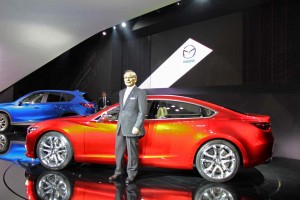Racking up mounting losses, Mazda is facing serious challenges that may require it to turn outside for help to resolve, the maker’s CEO confides.
That could mean seeking out a new partner to replace the once-powerful alliance between the Japanese automaker and America’s Ford Motor Co. It could also force Mazda to have to share its new and highly-touted SkyActiv powertrain technology with an erstwhile competitor.
Mazda is in a serious bind. The maker is forecasting a $1.3 billion loss for the current fiscal year, which ends March 31. And it is struggling to reverse a sales slide that saw it drop to 1.25 million units, a 2% dip, in calendar 2011.
The maker is meanwhile getting ready to walk away from its long-time manufacturing joint venture with Ford, known as Auto Alliance, where it had been producing the Mazda6 alongside the U.S. maker’s Mustang and other models. Though Mazda plans to produce some of its smaller models – the Mazda2 and Mazda3 — in Mexico, it will be particularly vulnerable to lopsided exchange rates once the Mazda6 returns to Japan.
In fact, of all the second-tier Japanese makers, none exports a higher share of its products from the home market – where the fast-rising yen has forced competitors like Toyota and Nissan to steadily reduce their production base.
Further compounding the situation, Mazda has been lagging behind in some key areas of advanced technology, especially battery-based drivetrains. Without a version of Ford’s gas-electric technology it doesn’t plan to have a hybrid of its own on the market until after mid-decade.
So, it’s no wonder that, as Automotive News is reporting, Mazda CEO Takashi Yamanouchi says his company is “actively” looking for alliance partners.
How far Mazda is willing to go remains uncertain. The company was, for much of the last two decades, effectively operating as the Japanese subsidiary of Ford Motor Co. That changed only after the arrival of Alan Mulally in 2006, the then-new Ford CEO putting a focus on the U.S. company’s core brands. Mulally sold off such European subsidiaries as Volvo and Jaguar and has slashed its stake in Mazda from 33% to just 4%.
Mazda is by no means the financial basket case it was when Ford initially took a controlling stake in the company a quarter century ago but it has been struggling to keep a healthy balance sheet. It raised $1.2 billion in a 2009 stock sale – directing much of that money to the development of its SkyActive system.
SkyActiv is a broad array of technologies, including a lightweight approach to platform development, but the primary elements are highly efficient gasoline and diesel four-cylinder engines and a matching automatic gearbox. (For more on SkyActiv, Click Here.)
Yamanouchi told Automotive News that raising additional capital is a “must,” adding that “We are considering every option.”
One possibility appears to be finding partners who might want access to the SkyActiv system. That might have seemed unlikely in decades past, but these days, “It’s partner or die,” said David Cole, chairman-emeritus of the Center for Automotive Research, in Ann Arbor, Michigan.
Even industry giant Toyota is reaching out to partners, forming alliances with giants Ford and BMW as well as battery-car start-up Tesla Motors – the latter providing the drivetrain for the new RAV4 EV launching later this year. (For more on Toyota’s alliance strategy, Click Here.)
Industry sources say Mazda is hoping it will also be able to get someone to replace Ford, at least in terms of providing technical expertise and research capital, even if it means losing its exclusivity with SkyActiv.


Quoted from the article:
“ It raised $1.2 billion in a 2009 stock sale – directing much of that money to the development of its SkyActive system. ”
The experience with the Wankel rotary engine makes Mazda wiser.
Now Mazda grasped the revolution the Miller-Cycle is capable of.
As soon as Mazda realized the potential of the SkyActive system, they had no option other than investing as much as Mazda could afford.
Mazda does know what a difference the simple / limited Miller-Cycle can bring about.
Pattakon knew the further difference the unlimited-Miller-cycles make.
The prototype car is at : http://www.pattakon.com/pattakonHydro.htm
It is a brand new Alfa Romeo Mito MutiAir 135 bhp modified to PatAir.
Pattakon is open for collaboration in order to sooner prove the huge advantage of the unlimited-Miller-cycle over the conventional Otto-cycle of the competitors.
If one Miller cycle is worth one billion $, what a billion different Miller cycles are worth of ?
Thanks
Manousos Pattakos